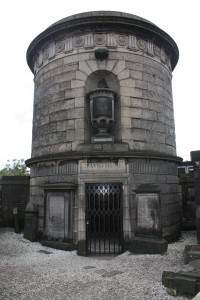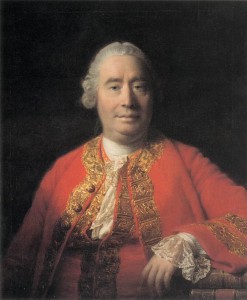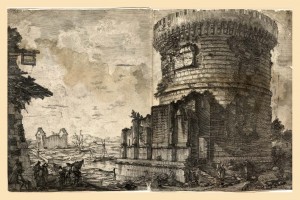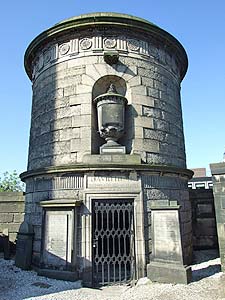 When Scottish Enlightenment philosopher David Hume died in 1776, his friend, famous architect Robert Adam, designed a mausoleum for him in the Old Calton Burying Ground in Edinburgh in keeping with Hume’s last wishes. Shortly before his death, Hume had written in his will: “I also ordain that, if I shall dye any where in Scotland, I shall be bury’d in a private manner in the Gallon Church Yard [aka Calton graveyard], the South Side of it, and a Monument be built over my Body at an Expence not exceeding a hundred Pounds, with an Inscription containing only my Name with the Year of my Birth and Death, leaving it to Posterity to add the Rest.”
When Scottish Enlightenment philosopher David Hume died in 1776, his friend, famous architect Robert Adam, designed a mausoleum for him in the Old Calton Burying Ground in Edinburgh in keeping with Hume’s last wishes. Shortly before his death, Hume had written in his will: “I also ordain that, if I shall dye any where in Scotland, I shall be bury’d in a private manner in the Gallon Church Yard [aka Calton graveyard], the South Side of it, and a Monument be built over my Body at an Expence not exceeding a hundred Pounds, with an Inscription containing only my Name with the Year of my Birth and Death, leaving it to Posterity to add the Rest.”
His request would be fulfilled, although later additions and alterations would mar the dignified simplicity of Hume’s vision. Before his monument could be built, however, the great Skeptic and Empiricist, had to be buried in the plot he had secured for himself in Calton.  The placid, even cheerful death (here’s how economist and friend Adam Smith described Hume’s final days in a letter to Hume’s literary executor, William Strahan) of so prominent an irreligious figure drew a great deal of public attention. Crowds assembled outside his house waiting to hear if he would change his mind about the improbability of an afterlife once death came a-knockin’.
The placid, even cheerful death (here’s how economist and friend Adam Smith described Hume’s final days in a letter to Hume’s literary executor, William Strahan) of so prominent an irreligious figure drew a great deal of public attention. Crowds assembled outside his house waiting to hear if he would change his mind about the improbability of an afterlife once death came a-knockin’.
After his burial, his friends stood guard at the grave site, pistols cocked and torches aloft, for eight days and nights to ensure Hume’s grave would not be desecrated or interfered with. It’s said that some of the curious hid behind gravestones to see if the Devil himself would come and spirit away the man James Boswell dubbed “the Great Infidel.” (Boswell, famous biographer of Samuel Johnson, had spoken to Hume just over a month before his death and had been shocked by his equanimity. Johnson insisted to Boswell that Hume must have been faking it. Boswell got drunk and had sex with a number of prostitutes, as was his wont when under stress. A lot of people were deeply invested in how Hume reacted to his impending death.)
 By 1778, Adam’s vision of Roman-inspired cylindrical mausoleum much like those found on the Appia Antica, complete with pre-fab decay, had been construction over Hume’s burial spot and an adjacent lot bought by the philosopher’s brother John. Robert Adam used unpolished masonry and rough ashlar to convey the impression of classical antiquity. Over the doorway was the simple inscription Hume had requested: “DAVID HUME, NATUS APRIL. 26. 1711. OBIIT AUGUST 25. 1776” At some point before 1813, for reasons lost in the mists of time, someone replaced the Latin “NATUS” with “BORN” and “OBIIT” with “DIED.”
By 1778, Adam’s vision of Roman-inspired cylindrical mausoleum much like those found on the Appia Antica, complete with pre-fab decay, had been construction over Hume’s burial spot and an adjacent lot bought by the philosopher’s brother John. Robert Adam used unpolished masonry and rough ashlar to convey the impression of classical antiquity. Over the doorway was the simple inscription Hume had requested: “DAVID HUME, NATUS APRIL. 26. 1711. OBIIT AUGUST 25. 1776” At some point before 1813, for reasons lost in the mists of time, someone replaced the Latin “NATUS” with “BORN” and “OBIIT” with “DIED.”
After that, some more wording was added even less in keeping with Hume’s vision. Hume’s nephew, a famous jurist also named David Hume, erected a memorial to his wife Jane Alder after her death in 1816. Her name was inscribed on funerary urn in a niche about the door and captioned with:
“Behold I come quickly
Thanks be to GOD which
giveth us the victory, through
our LORD JESUS CHRIST.”
Somewhere between then and 1820 yet another inscription was added just below the tablet, this one noting that the tomb was “Erected in Memory of Him/ in 1778” because by then the mausoleum had become something of a family vault, so its original purpose needed reiterating. During the mid-19th century, a metalwork cross was erected on a plinth above the keystone. The date 1841 is inscribed on it, perhaps indicating when the cross was added, perhaps in memoriam of Hume’s nephew David who had died in 1838. The cross was gone by the 1880s.
With Adam’s incorporating decay into the original design, plus all the later activity, plus the passage of time, Hume’s mausoleum was in dire need of cleaning and maintenance. The City of Edinburgh Council and Edinburgh World Heritage, plus a of private donors, pulled together to sponsor a proper conservation of the mausoleum this year, the 300th anniversary of Hume’s birth.
 Conservators focused on clearing vegetation and mortar pointing to replace crumbling mortar with fresh, durable lime. Particular attention was paid to the decorative elements on the cornice, architrave, and frieze around the top of the structure.
Conservators focused on clearing vegetation and mortar pointing to replace crumbling mortar with fresh, durable lime. Particular attention was paid to the decorative elements on the cornice, architrave, and frieze around the top of the structure.
A spokesman for Edinburgh World Heritage said: “The Hume mausoleum is of great importance to the city and Scotland. Designed by the famous architect Robert Adam to commemorate the nation’s foremost philosopher, it neatly encapsulates Edinburgh’s history as a city at the heart of the Enlightenment. This sort of conservation work is essential to keep the building in good order for the future, and to encourage more people to appreciate the value of the city’s historic graveyards.”
This was accomplished for the bargain price of £5,000 ($7864). Spend a little now so you don’t have to spend a lot later.